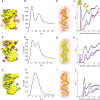The structural plasticity of nucleic acid duplexes revealed by WAXS and MD
- PMID: 33893104
- PMCID: PMC8064643
- DOI: 10.1126/sciadv.abf6106
The structural plasticity of nucleic acid duplexes revealed by WAXS and MD
Abstract
Double-stranded DNA (dsDNA) and RNA (dsRNA) helices display an unusual structural diversity. Some structural variations are linked to sequence and may serve as signaling units for protein-binding partners. Therefore, elucidating the mechanisms and factors that modulate these variations is of fundamental importance. While the structural diversity of dsDNA has been extensively studied, similar studies have not been performed for dsRNA. Because of the increasing awareness of RNA's diverse biological roles, such studies are timely and increasingly important. We integrate solution x-ray scattering at wide angles (WAXS) with all-atom molecular dynamics simulations to explore the conformational ensemble of duplex topologies for different sequences and salt conditions. These tightly coordinated studies identify robust correlations between features in the WAXS profiles and duplex geometry and enable atomic-level insights into the structural diversity of DNA and RNA duplexes. Notably, dsRNA displays a marked sensitivity to the valence and identity of its associated cations.
Copyright © 2021 The Authors, some rights reserved; exclusive licensee American Association for the Advancement of Science. No claim to original U.S. Government Works. Distributed under a Creative Commons Attribution NonCommercial License 4.0 (CC BY-NC).
Figures









Similar articles
-
Understanding nucleic acid structural changes by comparing wide-angle x-ray scattering (WAXS) experiments to molecular dynamics simulations.J Chem Phys. 2016 May 28;144(20):205102. doi: 10.1063/1.4950814. J Chem Phys. 2016. PMID: 27250330 Free PMC article.
-
Salt Dependence of A-Form RNA Duplexes: Structures and Implications.J Phys Chem B. 2019 Nov 21;123(46):9773-9785. doi: 10.1021/acs.jpcb.9b07502. Epub 2019 Nov 11. J Phys Chem B. 2019. PMID: 31638810 Free PMC article.
-
Insights into the structural stability of major groove RNA triplexes by WAXS-guided MD simulations.Cell Rep Phys Sci. 2022 Jul 20;3(7):100971. doi: 10.1016/j.xcrp.2022.100971. Epub 2022 Jul 11. Cell Rep Phys Sci. 2022. PMID: 35936555 Free PMC article.
-
Mechanisms and applications of peptide nucleic acids selectively binding to double-stranded RNA.Biopolymers. 2022 Feb;113(2):e23476. doi: 10.1002/bip.23476. Epub 2021 Sep 28. Biopolymers. 2022. PMID: 34581432 Review.
-
Single-molecule portrait of DNA and RNA double helices.Integr Biol (Camb). 2014 Oct;6(10):904-25. doi: 10.1039/c4ib00163j. Integr Biol (Camb). 2014. PMID: 25174412 Review.
Cited by
-
Sequence-Dependent Orientational Coupling and Electrostatic Attraction in Cation-Mediated DNA-DNA Interactions.J Chem Theory Comput. 2023 Oct 10;19(19):6827-6838. doi: 10.1021/acs.jctc.3c00520. Epub 2023 Sep 20. J Chem Theory Comput. 2023. PMID: 37728274 Free PMC article.
-
Modelling the structures of frameshift-stimulatory pseudoknots from representative bat coronaviruses.PLoS Comput Biol. 2023 May 19;19(5):e1011124. doi: 10.1371/journal.pcbi.1011124. eCollection 2023 May. PLoS Comput Biol. 2023. PMID: 37205708 Free PMC article.
-
Sampling globally and locally correct RNA 3D structures using Ernwin, SPQR and experimental SAXS data.Nucleic Acids Res. 2024 Sep 9;52(16):e73. doi: 10.1093/nar/gkae602. Nucleic Acids Res. 2024. PMID: 39021350 Free PMC article.
-
Atomistic structure of the SARS-CoV-2 pseudoknot in solution from SAXS-driven molecular dynamics.Nucleic Acids Res. 2023 Nov 10;51(20):11332-11344. doi: 10.1093/nar/gkad809. Nucleic Acids Res. 2023. PMID: 37819014 Free PMC article.
-
Principles of ion binding to RNA inferred from the analysis of a 1.55 Å resolution bacterial ribosome structure - Part I: Mg2.Nucleic Acids Res. 2025 Jan 7;53(1):gkae1148. doi: 10.1093/nar/gkae1148. Nucleic Acids Res. 2025. PMID: 39791453 Free PMC article.
References
-
- Conn G. L., Draper D. E., Lattman E. E., Gittis A. G., Crystal structure of a conserved ribosomal protein-RNA complex. Science 284, 1171–1174 (1999). - PubMed
-
- Bukhman Y. V., Draper D. E., Affinities and selectivities of divalent cation binding sites within an RNA tertiary structure. J. Mol. Biol. 273, 1020–1031 (1997). - PubMed
-
- Lu X.-J., Shakked Z., Olson W. K., A-form conformational motifs in ligand-bound DNA structures. J. Mol. Biol. 300, 819–840 (2000). - PubMed
Publication types
Grants and funding
LinkOut - more resources
Full Text Sources
Other Literature Sources

